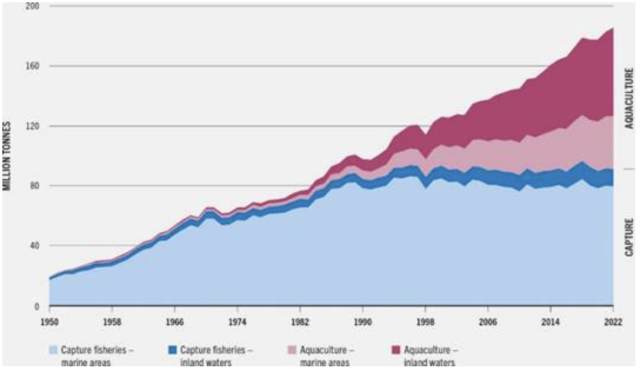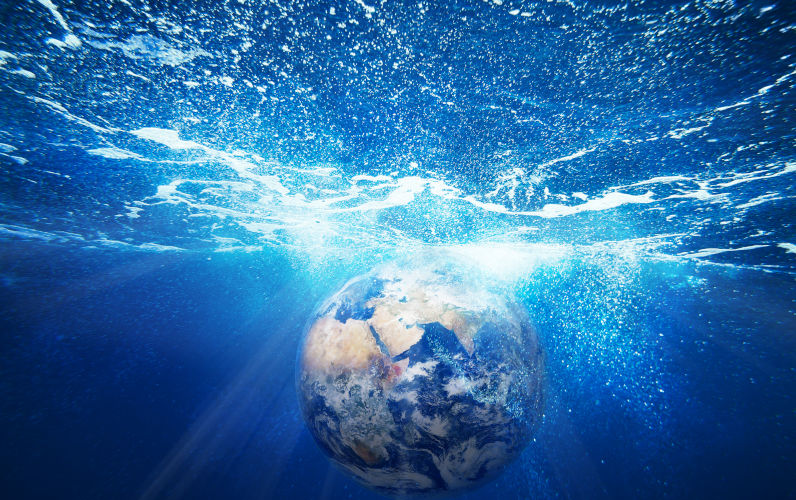Climate change causing oceans to decline at alarming rate
October 17, 2025
Climate change and human activity are causing the health of the world’s oceans to decline at an alarming rate, the UN has warned.
Overfishing, pollution, habitat destruction, and climate change are decimating marine species at frightening speeds, disrupting delicate food webs that have evolved over hundreds of millions of years.
The oceans support all life on Earth: covering 70% of the planet, they provide us with oxygen, rainfall and food, regulate the climate and are home to 80% of all living organisms.
The very idea that humans might become so voracious as to empty the seas of fish seemed absurd only a few short years ago. Today, scientific evidence points to a brutal reality from which there is no escape. In barely a generation, humans have exhausted the most prolific creatures on the planet.
The idea that humans might also befoul the vast oceans, altering their ecology, chemical balance, and role within the Earth system also seemed unlikely – until now.
Overfishing
“The global problem of overfishing is far worse than is currently recognised,” states marine ecologist Graham Edgar of the University of Tasmania
Edgar and his team investigated 230 of the world’s largest fisheries, spanning 128 fish species, and covering seas off the US, Europe, the UK, Canada, Argentina, South Africa, Australia and New Zealand.
What they found horrified them: for decades, governments around the planet, bending to the powerful marine lobby, have consistently overestimated the size of fish stocks. This has enabled them to permit far larger catches of fish that their natural lifecycles can support. As a result, fisheries everywhere are in trouble, and many are collapsing.

Figure 1. FAO data shows marine catches have been declining since the 1990s. However, the latest science suggests these official estimates are over-optimistic.
“We found populations of many overfished species are in far worse condition than has been reported, and the sustainability of fisheries was overstated. Urgent action is needed to ensure our oceans are not fished below their capacity to recover,” Edgar said.
Fish caught wild in the sea used to supply more than 90% of human seafood consumption. Today, that has dwindled to less than half of the 185 million tonnes of seafoods consumed worldwide, according to the UN Food and Agriculture Organisation. Farmed fish, like salmon, prawns and basa catfish, have taken over.
Overfishing is not the only problem. There is also the huge seabed destruction caused by trawling and the illegal by-catch of non-target species like sharks, turtles, dolphins, seals and albatrosses. Although seabirds are not caught for food, they have sustained a massive global population crash of more than 70% since the 1950s, highlighting the huge collateral damage caused by human activities like longline fishing and plastic waste in the oceans.
Pollution
Humans discharge as much as 220 billion tonnes of chemical emissions into the environment every year, poisoning every person and living creature without distinction. Carried by wind, water and waste disposal, most of that ends up in the oceans where it accumulates to form an ever-growing toxic menace to sea life.
The bulk of the emissions consist of eroded topsoil, mining wastes, the residue from burning fossil fuels and industrial discharges, but humans have also been known to dump toxic mineral wastes, chemical weapons and other poisons directly into the sea in the belief nobody will notice.
Every year, 19-23 million tonnes of plastic waste leak into aquatic ecosystems, polluting lakes, rivers and seas. Emissions of plastic waste into aquatic ecosystems are forecast to triple by 2040 without meaningful action, the UN Environmental Program warns.
The volume of plastics in the ocean has been estimated to total around 75-199 million tonnes, in 171 trillion separate pieces. This now entering consumers everywhere via the seafood chain.
Climate
In one of the most glaring examples of humanity’s ability to wreck the Earth’s systems, we are altering the ability of the oceans to regulate the world’s climate.
The ocean acts as a driver of both climate and weather by absorbing, storing and redistributing heat, influencing atmospheric circulation, and regulating the carbon cycle. Its vastness and thermal inertia determine long-term climate patterns, while its interactions with the atmosphere shape daily weather events.
The ocean naturally absorbs CO2 through gas exchange. The amount of CO2 in the ocean depends on water temperature, salinity and biological activity. Since the 1850s, the oceans have absorbed about 25% of human carbon emissions and thus helped to slow slowed climate change – but there is now disturbing evidence this process is breaking down. If this trend persists, then by heating the oceans, humanity will literally reduce their capacity to cool the planet, cooking ourselves and all life all the faster.
Acidification
The world’s oceans are slowly becoming more acidic due to changes in seawater chemistry due to the absorption of CO2 from the air which is released by human burning of fossil fuels and felling of forests. Globally, ocean acidity has increased by 30% compared with pre-industrial times.
The changes are attacking the shells and skeletons of marine animals, including corals, plankton and fishes, undermining the ocean food chain.
Dead zones
The size and number of marine dead zones — areas where the deep water is so low in dissolved oxygen that fish and other sea creatures cannot survive — have grown explosively in the past half-century.
Dead zones mostly occur offshore from places where humans are overpopulated, chiefly round Europe, East Asia and eastern America. Heavy runoff of fertilisers, pesticides, silt and industrial wastes are all major factors linked to these dying seas. This runoff triggers vast blooms of marine algae which then collapse when they run out of nutrients, leading to decomposition that strips the oxygen from the water. Fish, crabs, prawns and other sea life usually die. This process is known as eutrophication.
Oxygen loss
The loss of oxygen from the world’s oceans is approaching critical levels. Globally, the ocean has lost about 2% of its dissolved oxygen since the 1950s and is expected to lose up to 7% by 2100.
Driven by climate change, stratification, nitrogen fallout (from vehicle emissions) and eutrophication, it poses a real threat to sea life, marine ecosystems and human livelihoods. In the past, ocean deoxygenation is thought by science to have been a major factor behind the greatest extinction events in Earth’s history. They fear the process is now underway once again.
At least half of the breathable oxygen in the Earth’s atmosphere comes out of the ocean, so the decay and collapse of the marine oxygen cycle holds major implications for whether humans can continue to inhabit Planet Earth in the longer term.
Humans require a minimum oxygen concentration of 19.5% in the atmosphere to survive: the current global level is 20.95%, and falling. The loss of atmospheric oxygen is driven by three main processes – the damage caused by humans to the oceans, deforestation of land, climate change and eutrophication.
The vast accumulation of evidence shows the human impact on Planet Earth has attained geological scale. We have become an “event” with the destructive force of a supervolcano or large asteroid impact, but one that appears to be happening in slow-motion in terms of our own limited perceptions. Nevertheless, it is rapidly approaching the point of irreversibility – and there is, as yet, no sign that humans collectively understand what they have unleashed, or how to repair the damage. Indeed, most societies are focused on redoubling the destruction and ensuring their grandchildren have no future.
The views expressed in this article may or may not reflect those of Pearls and Irritations.
